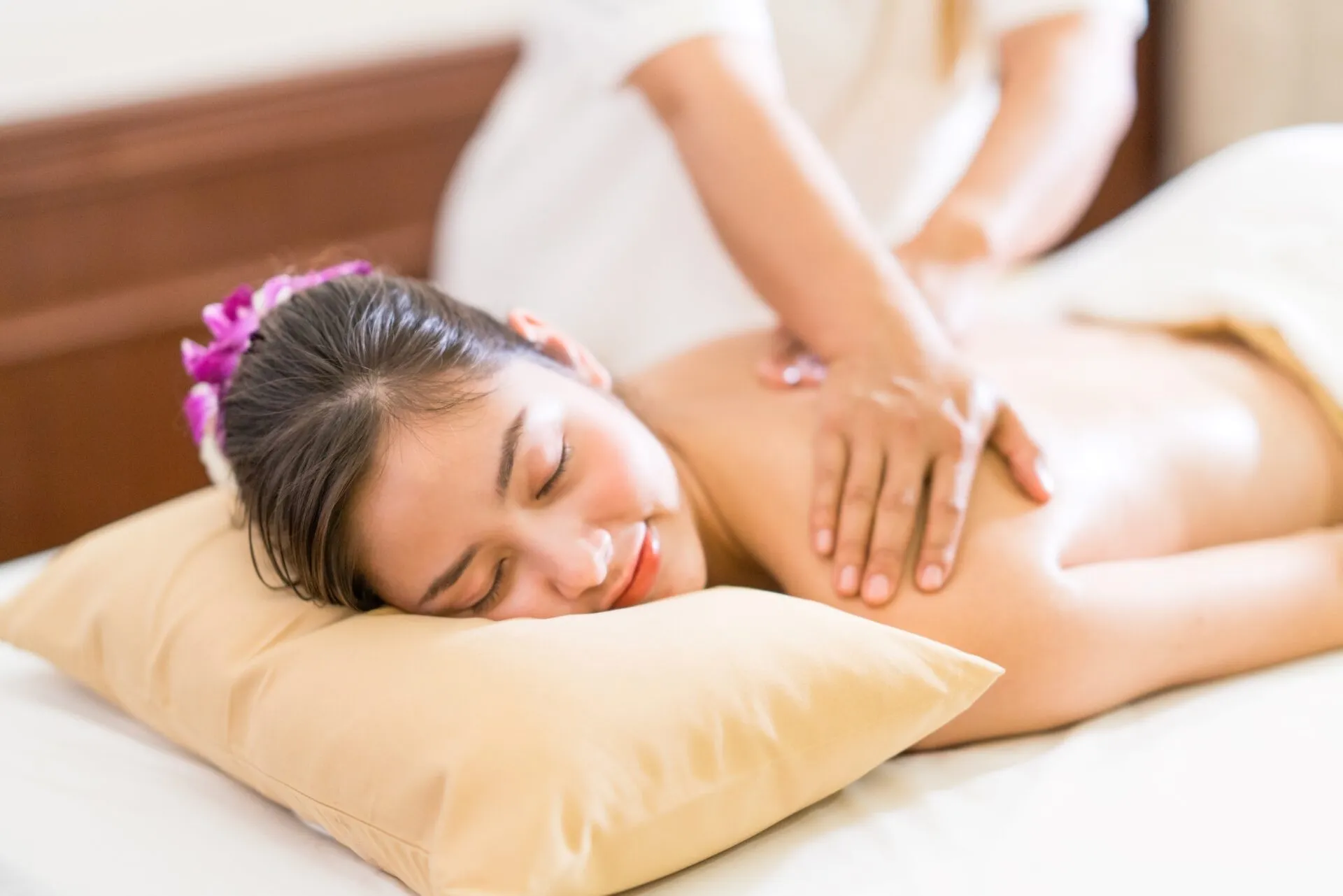Our Services
Spa Center
Welcome to our spa center, where relaxation meets luxury. Experience rejuvenating treatments in a tranquil environment designed to refresh your mind, body, and soul.
Have a Look at Our Services
Massage therapy center
Our massage therapy center offers a range of specialized treatments designed to relieve stress, ease tension, and promote overall wellness. Experience personalized care in a serene and soothing environment.
01.Ayurvedic Massage
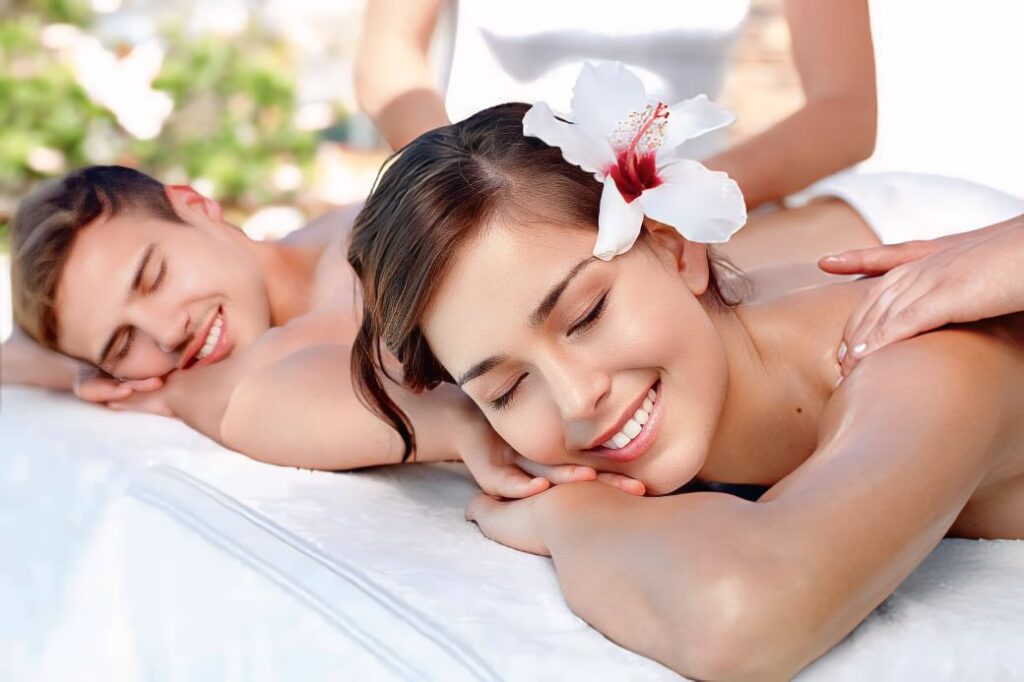
Ayurvedic massage is a traditional form of massage therapy rooted in Ayurveda, an ancient holistic healing system that originated in India over 5,000 years ago. This massage technique is designed to balance the body, mind, and spirit by using a combination of herbal oils, specific massage strokes, and pressure points to promote overall well-being and harmony.
Ayurvedic massage focuses not just on relieving physical pain or discomfort but also on enhancing the body’s natural healing processes. It is believed to cleanse the body of toxins, improve circulation, and restore the flow of energy, or “prana,” throughout the body. The massage is often personalized to an individual’s unique constitution, or “dosha,” which determines the specific techniques and oils used.

Working Process of Ayurvedic Massage:
The process of Ayurvedic massage involves several key steps and techniques designed to provide a holistic healing experience:
1. Determination of Dosha Type
Before the massage begins, the Ayurvedic practitioner or therapist will assess your dosha type—Vata, Pitta, or Kapha. This assessment may involve a short consultation where the practitioner asks questions about your lifestyle, diet, and health concerns. Each dosha represents different elements and energies within the body:
- Vata: Associated with air and space, Vata governs movement and communication. Imbalance in Vata can lead to anxiety, dryness, and joint pain.
- Pitta: Linked with fire and water, Pitta controls digestion and metabolism. An excess of Pitta can cause inflammation, anger, and digestive issues.
- Kapha: Connected with earth and water, Kapha influences stability and structure. Imbalance in Kapha can lead to lethargy, congestion, and weight gain.
Understanding your dosha helps the practitioner choose the appropriate oils, herbs, and massage techniques tailored to your specific needs.
2. Selection of Herbal Oils
Ayurvedic massage typically uses warm herbal oils infused with natural ingredients that align with your dosha. These oils are specifically chosen for their therapeutic properties and ability to penetrate deep into the skin, nourishing tissues and balancing energies. Common oils used include sesame, coconut, and mustard oils, often mixed with herbs such as turmeric, ashwagandha, or brahmi.
3. Preparation and Relaxation
The massage begins with a few minutes of relaxation, where the client is asked to lie down on a massage table or mat. The therapist may use breathing exercises or meditation to help the client enter a calm and receptive state.
4. Application of Warm Herbal Oils
The therapist then applies warm herbal oils to the body. The oil is gently warmed to enhance its therapeutic benefits and to help the muscles relax. The warmth of the oil also allows the skin to better absorb the herbs and nutrients, promoting deeper healing.
5. Massage Techniques and Strokes
Ayurvedic massage involves a variety of techniques that differ based on the client’s dosha and specific health needs:
- Abhyanga: A full-body massage that involves rhythmic, flowing strokes to stimulate the lymphatic system, promote circulation, and remove toxins. It is often performed with synchronized movements by one or two therapists.
- Shirodhara: A specialized technique where warm oil is poured in a steady stream onto the forehead, particularly on the “third eye” area. This is deeply relaxing and is believed to calm the mind, reduce stress, and enhance mental clarity.
- Marma Therapy: Focuses on stimulating specific energy points (marma points) on the body to release blocked energy and promote healing.
- Pizhichil: A combination of oil massage and heat therapy where warm oil is poured over the body in a continuous stream. This technique is particularly beneficial for muscle and joint pain.
6. Focus on Pressure Points
Ayurvedic massage also incorporates acupressure-like techniques that focus on various marma points or energy centers in the body. These points are believed to be intersections of flesh, veins, arteries, bones, and joints, and manipulating them can help balance the body’s energy flow and improve overall vitality.
7. Finishing and Rest
After the massage, the client is usually left to rest for a few minutes to allow the oils and herbs to be fully absorbed into the skin. This period also allows the body to relax and integrate the benefits of the massage. Some treatments may conclude with a steam bath or herbal sauna to enhance detoxification and relaxation.
8. Post-Massage Care
Post-massage care includes advice on lifestyle changes, dietary recommendations, and herbal supplements that align with your dosha type. These suggestions are aimed at maintaining the balance achieved during the massage and promoting long-term health and well-being.
Conclusion
Ayurvedic massage is a powerful tool for promoting holistic health, focusing not just on physical wellness but also on mental and spiritual well-being. By incorporating warm herbal oils, specific massage techniques, and pressure points, this ancient practice offers a unique and personalized approach to healing and rejuvenation. Whether you are looking to relieve stress, detoxify the body, or balance your dosha, Ayurvedic massage can provide a comprehensive solution tailored to your individual needs.
02.Aromatherapy Massage
Aromatherapy massage is a therapeutic practice that combines the healing benefits of massage therapy with the use of essential oils derived from plants, flowers, and herbs. This form of massage is designed to enhance physical, emotional, and spiritual well-being through the aromatic properties of essential oils, which are believed to have various health benefits, such as reducing stress, alleviating pain, and improving mood.
Essential oils are highly concentrated extracts that capture the plant’s scent and beneficial properties. Each oil has unique characteristics, and the choice of oils is tailored to the individual’s needs. Aromatherapy massage not only relaxes the muscles and eases tension but also engages the olfactory senses, providing a holistic approach to wellness that addresses both the mind and body.
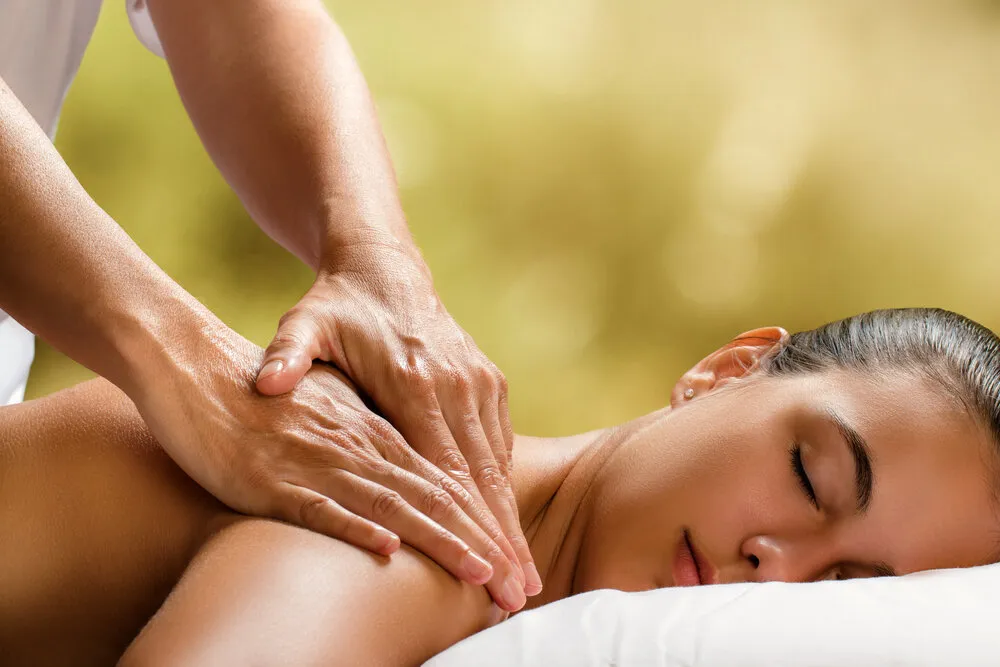
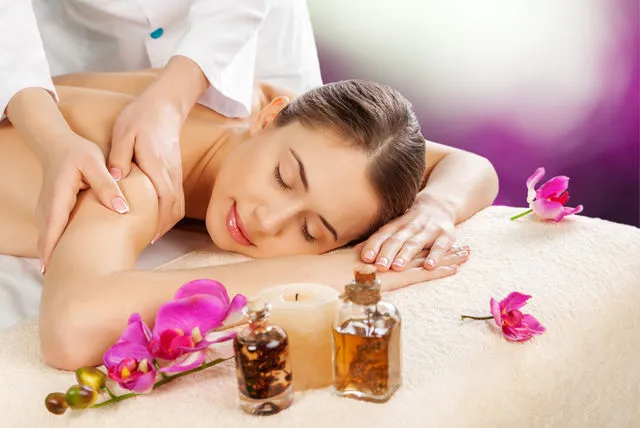
Working Process
The process of an aromatherapy massage involves several key steps designed to provide a relaxing and rejuvenating experience:
1. Consultation and Oil Selection
Before the massage begins, the therapist conducts a brief consultation to understand the client’s health concerns, preferences, and desired outcomes. Based on this information, the therapist selects specific essential oils that match the client’s needs. Some commonly used essential oils in aromatherapy massage include:
- Lavender: Known for its calming and relaxing properties, it helps reduce stress and anxiety.
- Peppermint: Refreshing and invigorating, it helps relieve headaches and improve concentration.
- Eucalyptus: Has antiseptic and anti-inflammatory properties, beneficial for respiratory issues and muscle pain.
- Tea Tree: Used for its antimicrobial and healing properties, suitable for skin issues.
- Chamomile: Soothing and calming, it helps with insomnia, stress, and skin conditions.
The oils may be blended to create a customized mixture that addresses the specific needs of the client, such as relaxation, pain relief, or energy boosting.
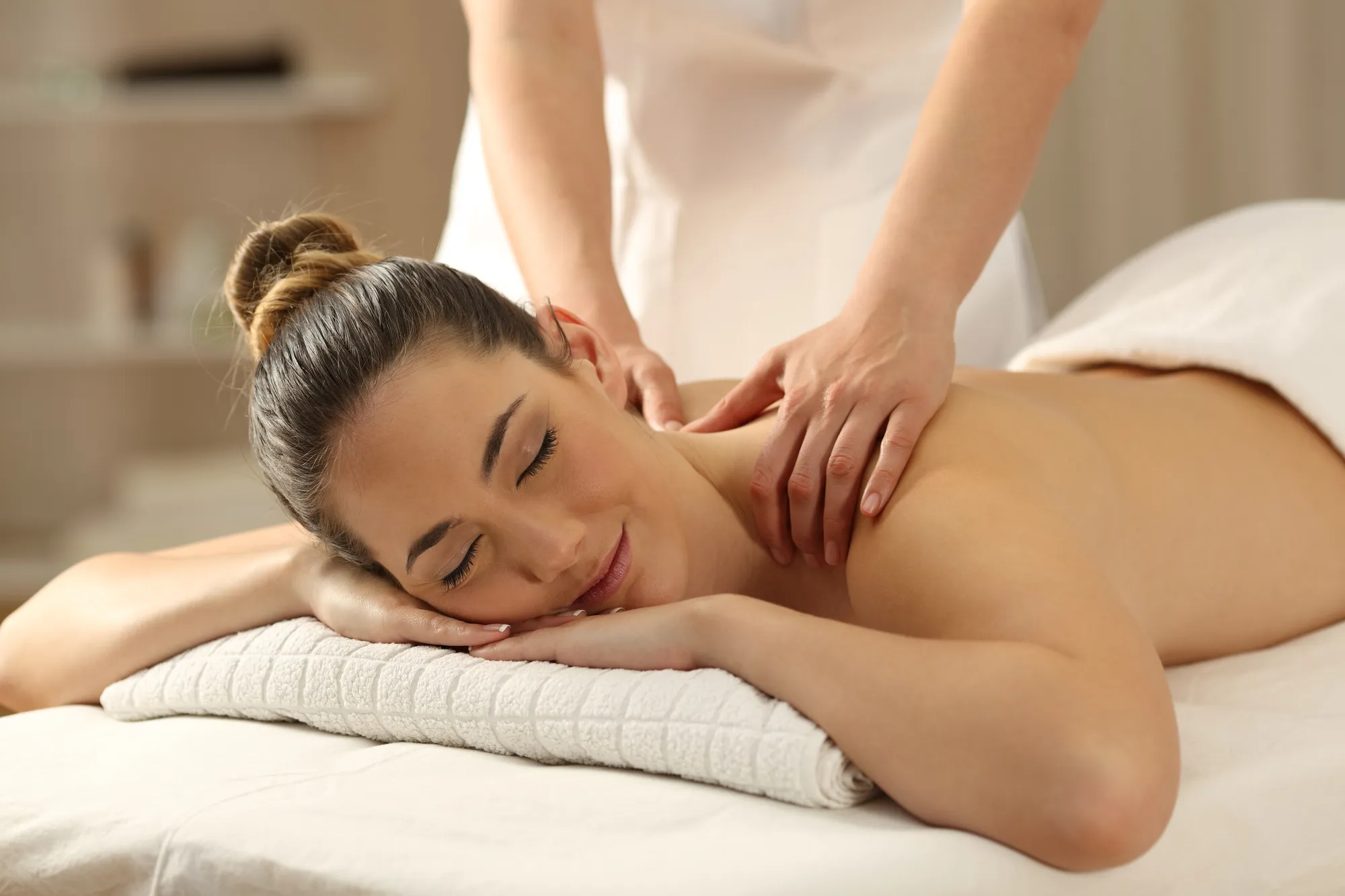
2. Preparation and Environment
The environment plays a crucial role in aromatherapy massage. The massage room is typically set up to create a calming and tranquil atmosphere, with dim lighting, soft music, and aromatic diffusers or candles that enhance the therapeutic experience. The client is asked to lie comfortably on a massage table, often under a warm blanket or sheet to ensure relaxation.
3. Blending Essential Oils with Carrier Oils
Essential oils are highly concentrated and are typically diluted with a carrier oil before application to the skin. Carrier oils, such as almond oil, jojoba oil, or coconut oil, help to dilute the essential oils, making them safe for topical use while also providing additional moisturizing benefits. The therapist prepares the blend, ensuring that the concentration of essential oils is appropriate for the client’s skin type and sensitivity.
4. Application of the Aromatherapy Oil
The therapist applies the aromatherapy oil blend to the skin using gentle, flowing massage strokes. The choice of techniques may vary, but common ones include:
- Effleurage: Long, sweeping strokes that help spread the oil and warm up the muscles.
- Petrissage: Kneading movements to release tension and improve circulation.
- Friction: Deeper, circular movements that target specific muscle knots and areas of tension.
- Tapotement: Light tapping or percussion movements to stimulate and invigorate the muscles.
These massage techniques help the essential oils penetrate deeply into the skin, enhancing their therapeutic effects while also promoting relaxation and relieving muscle tension.
5. Inhalation of Essential Oils
During the massage, the client also benefits from the inhalation of the essential oils’ aromatic compounds. As the oils are applied and warmed by the skin, their scent fills the room, allowing the client to breathe in the therapeutic aromas. The olfactory system is directly linked to the brain’s limbic system, which is responsible for emotions and memory. Inhaling essential oils can trigger emotional responses, reduce stress, and promote a sense of calm and well-being.
6. Targeted Massage Techniques
Aromatherapy massage can be customized to focus on specific areas of concern, such as the back, neck, shoulders, or feet. The therapist may use different techniques to address these areas, combining the benefits of essential oils with targeted massage to alleviate pain, reduce muscle tension, and improve overall circulation.
7. Post-Massage Relaxation
After the massage, the client is usually given a few minutes to rest and allow the oils to fully absorb into the skin. This period of rest also allows the body and mind to integrate the benefits of the massage. The therapist may provide water or herbal tea to help the client rehydrate and flush out any toxins released during the massage.
8. Aftercare and Recommendations
The therapist may offer aftercare advice and recommend specific essential oils or blends for continued use at home to maintain the therapeutic benefits of the aromatherapy massage. They might also suggest lifestyle changes, such as incorporating aromatherapy into daily routines, practicing relaxation techniques, or using an essential oil diffuser for ongoing benefits.
Conclusion
Aromatherapy massage is a holistic therapy that combines the healing power of touch with the therapeutic benefits of essential oils. This massage technique offers a unique approach to wellness, addressing both physical and emotional needs. Whether you are looking to relax, reduce stress, alleviate pain, or simply enjoy the benefits of essential oils, aromatherapy massage provides a comprehensive solution that nurtures the body, mind, and spirit.
03.Hot Stone Massage
This massage uses heated stones placed on specific parts of the body to relax muscles, improve circulation, and alleviate pain.

A hot stone massage is a therapeutic and relaxing treatment that combines traditional massage techniques with the application of heated stones. This popular massage therapy is known for its ability to ease muscle tension, improve circulation, and promote a sense of deep relaxation.
What is a Hot Stone Massage?
Hot stone massage involves placing smooth, heated stones on specific points of the body. The stones are typically made of basalt, a type of volcanic rock that retains heat well. The warmth of the stones helps to relax muscles, allowing the massage therapist to work more deeply and effectively.
Benefits of Hot Stone Massage
- Muscle Relaxation: The heat from the stones penetrates deeply into the muscles, helping to release tension and tightness.
- Improved Circulation: The warmth increases blood flow to the area being treated, which can help with pain relief and healing.
- Reduced Stress and Anxiety: The soothing nature of the hot stone massage helps to calm the mind, reduce stress, and promote overall relaxation.
- Enhanced Sleep Quality: The relaxation achieved from a hot stone massage can improve sleep patterns and help with insomnia.
- Pain Relief: It can alleviate pain related to muscle tension, arthritis, and other conditions.
How is a Hot Stone Massage Performed?
During a hot stone massage, the therapist first heats the stones in water to a specific temperature. They then place the stones on key points of the body, such as the back, hands, feet, and even the face. The therapist may also use the stones as an extension of their hands to perform various massage techniques, such as gliding, kneading, and circular movements. The combination of heat and massage helps to melt away muscle tension and improve flexibility.
Who Can Benefit from Hot Stone Massage?
Hot stone massage is suitable for most people, especially those looking for relaxation, stress relief, or relief from muscle tension and pain. However, it may not be ideal for individuals with certain conditions such as diabetes, high blood pressure, heart disease, or skin sensitivity. It’s always best to consult with a healthcare provider before undergoing any new type of massage therapy.
Conclusion
A hot stone massage is more than just a luxurious spa treatment—it’s a powerful tool for promoting physical and mental well-being. By combining the benefits of heat with the therapeutic effects of massage, this treatment offers a unique way to relieve stress, reduce muscle tension, and enhance overall health.
Would you like to learn more about different types of massages or specific techniques?
04.Swedish Massage
Swedish massage is one of the most popular and well-known forms of massage therapy in the world. Developed in the 19th century by Swedish physiologist Per Henrik Ling, this technique focuses on relaxing the entire body through gentle, flowing strokes. Swedish massage is designed to enhance blood circulation, increase relaxation, relieve muscle tension, and promote overall physical and mental well-being. It is an excellent choice for anyone new to massage therapy or seeking a relaxing and therapeutic experience.
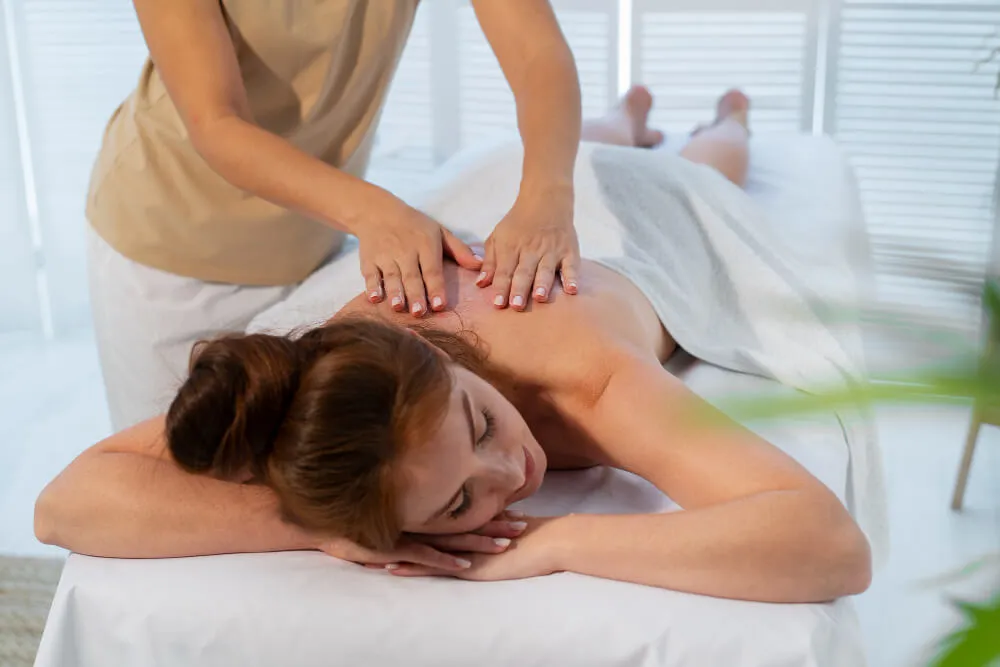
Working Process
The process of a Swedish massage involves several key steps, each tailored to provide maximum relaxation and therapeutic benefits:
1. Initial Consultation
Before the massage begins, the therapist will conduct a brief consultation to understand your health history, any areas of discomfort or tension, and your preferences for pressure (light, medium, or firm). This information helps the therapist customize the massage to meet your specific needs.
2. Preparation and Environment
The environment for a Swedish massage is usually calm and soothing, with dim lighting, soft music, and a comfortable massage table. You will be asked to lie down on the table, covered with a sheet or towel for modesty and comfort. The therapist will expose only the area being worked on, ensuring that you feel comfortable and relaxed throughout the session.
3. Application of Massage Oil or Lotion
To reduce friction and enhance the smooth, flowing strokes characteristic of Swedish massage, the therapist will apply a massage oil or lotion to your skin. This also helps nourish and hydrate the skin while allowing the therapist to glide their hands more easily over your muscles.
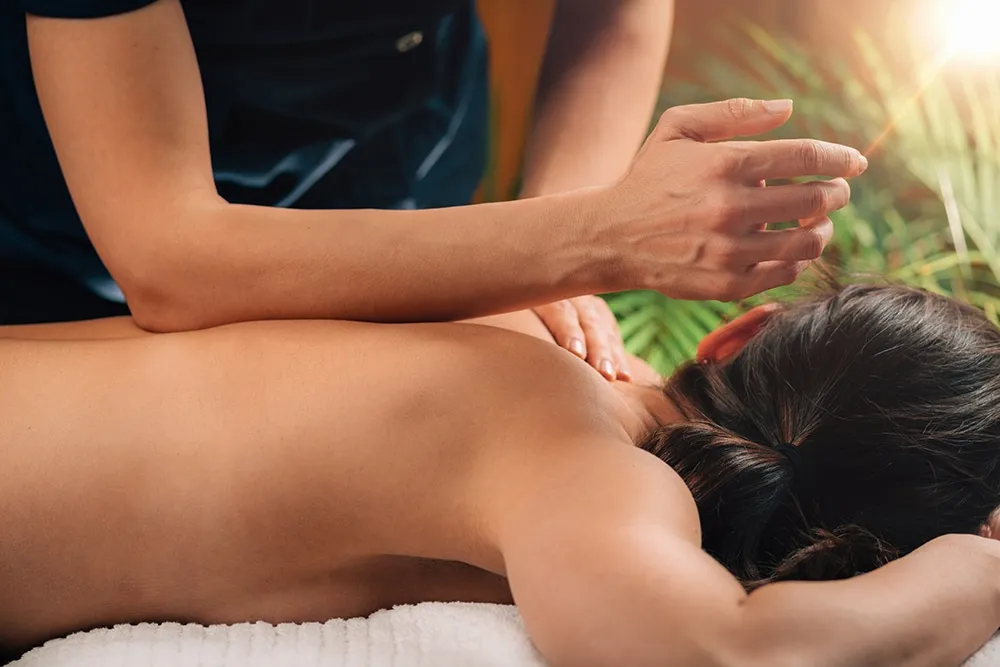
4. Massage Techniques Used in Swedish Massage
Swedish massage incorporates a variety of techniques, each with its own therapeutic benefits:
Effleurage: Long, gliding strokes performed with the palms, fingers, or thumbs. This technique warms up the muscles, promotes relaxation, and enhances circulation. Effleurage is often used at the beginning and end of the massage.
Petrissage: A kneading technique that involves lifting, rolling, and squeezing the muscles. Petrissage helps to release muscle knots and tension, improve flexibility, and stimulate deeper tissues.
Friction: Deep, circular rubbing movements that help break down adhesions (knots) in muscles and connective tissues. This technique is particularly useful for areas with more severe tension or stiffness.
Tapotement: Rhythmic tapping or percussion movements using the edge of the hand, cupped hands, or fingertips. Tapotement stimulates nerve endings, improves circulation, and energizes the muscles.
Vibration and Shaking: Gentle shaking or vibrating movements that help relax muscles and soothe the nervous system. This technique is often used towards the end of the massage to help the client relax further.
5. Focus on Problem Areas
If there are specific areas of tension or discomfort, the therapist may spend extra time focusing on those areas using targeted techniques. This personalized approach helps to address particular issues such as back pain, neck stiffness, or sore shoulders.
6. Finishing and Relaxation
The massage typically ends with light, relaxing strokes to calm the body and promote a state of deep relaxation. The therapist may gently stretch certain muscle groups to improve flexibility and range of motion. You will then be given a few moments to rest and enjoy the relaxed state.
7. Post-Massage Advice
After the massage, the therapist may provide some advice on post-massage care, such as staying hydrated, avoiding strenuous activities, and doing some gentle stretching exercises to maintain flexibility. You may also be encouraged to take a warm bath or shower to enhance the relaxation effects of the massage.
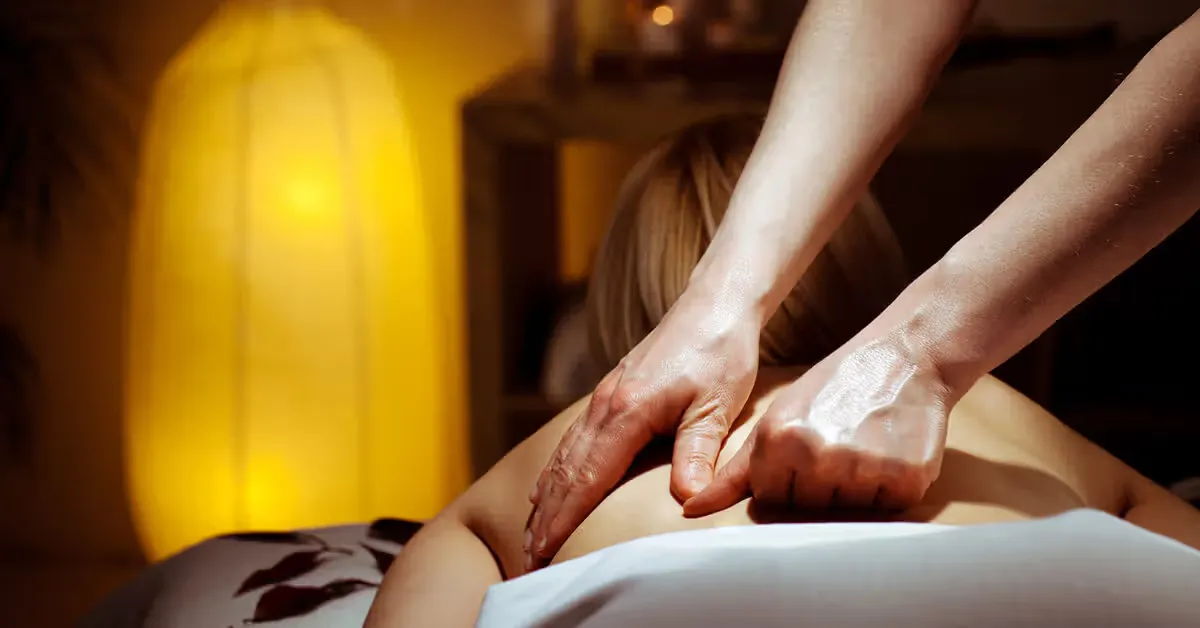
Benefits of Swedish Massage
Swedish massage offers a wide range of benefits for both the body and mind, including:
Relieves Muscle Tension and Pain: The gentle kneading and stroking techniques help to release muscle knots and alleviate pain caused by tension and stress.
Improves Circulation: The massage strokes help increase blood flow throughout the body, which can enhance the delivery of oxygen and nutrients to tissues and promote healing.
Reduces Stress and Anxiety: Swedish massage is known for its calming effects on the nervous system, which can help lower stress levels, reduce anxiety, and improve mood.
Enhances Flexibility and Range of Motion: The stretching and kneading techniques used in Swedish massage help to improve flexibility and increase the range of motion in the joints.
Promotes Relaxation and Better Sleep: The soothing and relaxing nature of Swedish massage can help improve sleep quality and promote overall relaxation, making it a great choice for those suffering from insomnia or sleep disturbances.
Boosts Immune Function: By reducing stress and improving circulation, Swedish massage may also help boost the immune system, making the body more resilient against illnesses.
Helps Detoxify the Body: The massage techniques stimulate the lymphatic system, which helps remove toxins from the body and supports overall detoxification.
Improves Mental Clarity and Focus: The relaxation achieved through Swedish massage can enhance mental clarity, focus, and concentration by reducing mental fatigue and tension.
Conclusion
Swedish massage is an excellent choice for anyone looking to relax, reduce stress, and improve their overall health and well-being. Its combination of soothing strokes, gentle kneading, and targeted pressure provides a holistic approach to wellness that benefits both the body and mind. Whether you are a first-time client or a regular massage enthusiast, Swedish massage offers a relaxing and therapeutic experience that can be tailored to meet your individual needs.
05.Deep Tissue Massage
Deep tissue massage is a type of massage therapy that focuses on realigning deeper layers of muscles and connective tissue. It is particularly beneficial for individuals who suffer from chronic pain, muscle tension, or sports-related injuries. Unlike a Swedish massage, which is more about relaxation, deep tissue massage uses slower strokes and more intense pressure to target deeper muscle fibers and fascia (the connective tissue surrounding muscles). This technique helps release tension, break down scar tissue, and improve overall muscle function.
Deep tissue massage is often used to treat specific physical conditions, such as stiff necks, upper back pain, lower back pain, leg muscle tightness, and sore shoulders. It can be quite therapeutic, especially for those dealing with chronic pain or sports injuries, as it focuses on releasing tension in the deeper muscle layers and fascia.
.
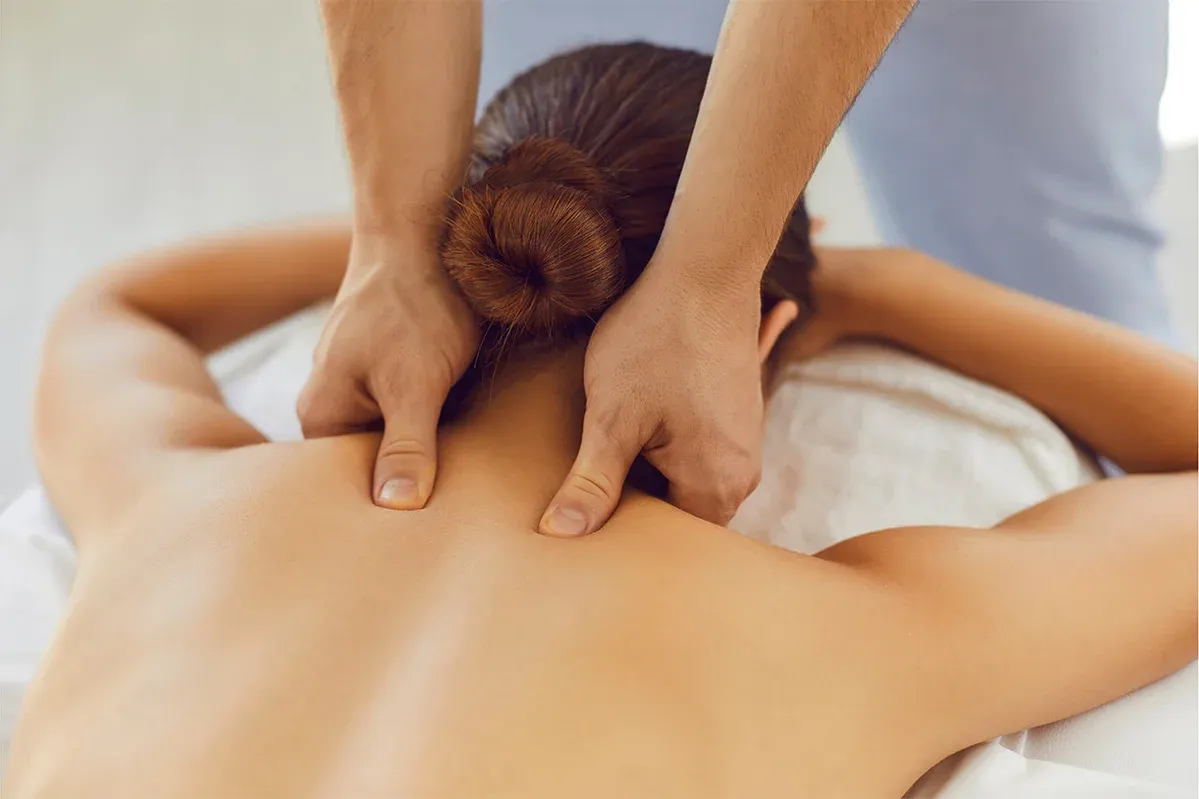
Working Process
The process of a deep tissue massage involves several key steps, each aimed at relieving muscle tension and improving flexibility and circulation:
1. Initial Consultation
Before beginning the massage, the therapist will conduct a consultation to understand your specific concerns, medical history, and any areas of discomfort. This helps the therapist tailor the massage to address your particular needs. They will ask about your pain tolerance, any injuries, and areas that need more attention, ensuring the massage is both effective and safe.
2. Preparation and Environment
The massage typically takes place in a calm and quiet environment, with dim lighting and soothing music to promote relaxation. You will be asked to lie down on a massage table, usually covered with a sheet or towel for modesty and comfort.
3. Application of Massage Oil or Lotion
To minimize friction and allow for smooth, deep strokes, the therapist will apply a massage oil or lotion to the skin. This also helps to nourish and hydrate the skin while enabling the therapist to glide their hands more easily over the muscles.
4. Warm-Up and Initial Techniques
The massage usually begins with lighter strokes, known as effleurage, to warm up the muscles and prepare them for deeper work. This initial phase helps to increase blood flow to the muscles and make them more pliable, reducing the risk of injury when applying deeper pressure.
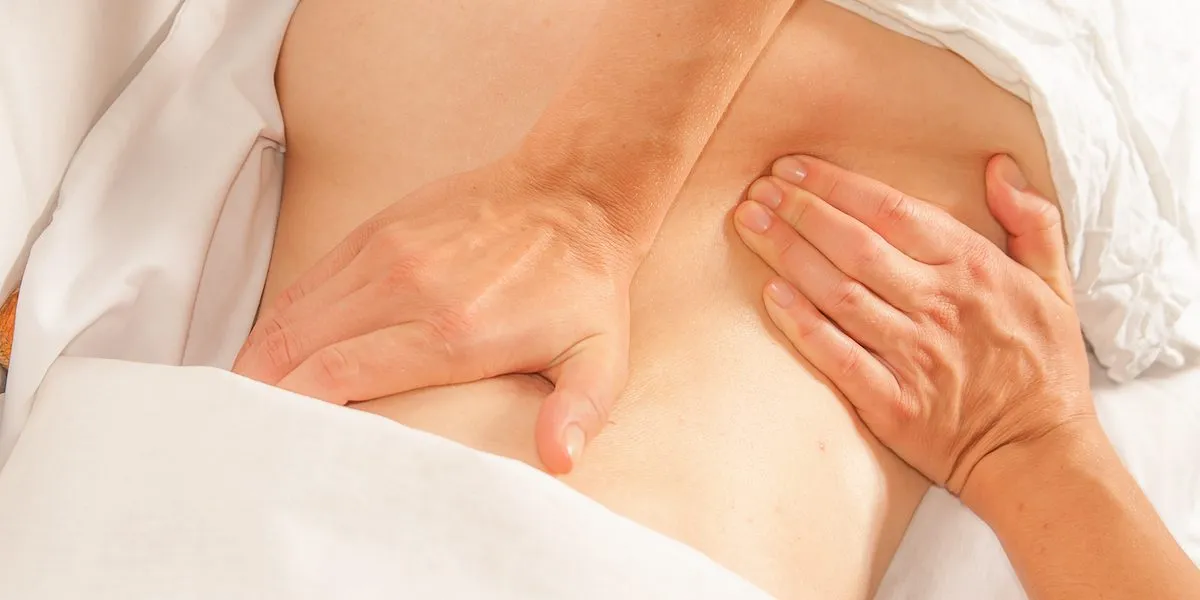
5. Deeper Techniques and Targeted Pressure
Once the muscles are warmed up, the therapist will gradually apply deeper pressure to target specific muscle groups and areas of tension. The techniques used in deep tissue massage include:
Stripping: A technique that involves using deep, gliding pressure along the length of the muscle fibers. The therapist often uses their thumbs, knuckles, or elbows to apply slow, firm strokes that help release tight muscles and break down adhesions (bands of painful, rigid tissue).
Friction: Firm, circular movements that create heat and friction to target deeper muscle layers. This technique is used to break up scar tissue and improve flexibility.
Cross-Fiber Friction: Applying pressure against the grain of the muscle fibers to break down adhesions and scar tissue that may have formed due to injury or chronic muscle tension.
Trigger Point Therapy: Applying sustained pressure to specific areas (trigger points) where muscle knots have formed. This technique helps release tension in those knots, reducing pain and improving muscle function.
6. Focus on Problem Areas
The therapist may spend extra time on areas that are particularly tight or painful. Communication between the client and therapist is essential during a deep tissue massage, as the pressure can sometimes be intense. You should always feel comfortable asking the therapist to adjust the pressure if it becomes too painful.
7. Finishing Techniques and Relaxation
The massage usually ends with lighter strokes to help calm the body and promote relaxation after the intense work on deeper tissues. This phase helps soothe the nervous system and allows the muscles to recover from the deep pressure.
8. Post-Massage Care and Recommendations
After the massage, the therapist may provide advice on aftercare, such as drinking plenty of water to help flush out toxins released during the massage, applying ice to sore areas if needed, and doing gentle stretching exercises to maintain flexibility and prevent muscle soreness. It’s normal to feel some soreness or stiffness after a deep tissue massage, but this should subside within a day or two.
Benefits of Deep Tissue Massage
Deep tissue massage offers several benefits, particularly for those dealing with chronic pain, sports injuries, or muscle tension:
Relieves Chronic Pain: By focusing on deeper muscle layers and connective tissues, deep tissue massage can effectively reduce chronic pain associated with conditions like lower back pain, arthritis, and fibromyalgia.
Reduces Muscle Tension and Spasms: The deep pressure techniques used in this massage help release muscle knots, reduce spasms, and alleviate muscle tightness.
Improves Blood Circulation: Deep tissue massage promotes better circulation by helping to release tension in the deeper muscle layers. Improved circulation brings more oxygen and nutrients to the muscles, promoting healing and reducing inflammation.
Breaks Down Scar Tissue: Regular deep tissue massage can help break down scar tissue that forms after injuries, surgeries, or chronic muscle tension, improving flexibility and range of motion.
Enhances Mobility and Flexibility: By releasing tight muscles and breaking down adhesions, deep tissue massage improves overall mobility and flexibility, making it particularly beneficial for athletes or individuals recovering from injuries.
Reduces Stress and Anxiety: While deep tissue massage is more intense than other forms, it can still provide significant stress relief by relaxing the deeper muscles and releasing tension held in the body.
Aids in Injury Recovery: Deep tissue massage can help speed up the recovery process from sports injuries or overuse injuries by reducing inflammation and promoting healing in the deeper muscle layers.
Improves Posture: By releasing muscle tension and addressing areas of chronic pain, deep tissue massage can help improve posture and alleviate the discomfort associated with poor posture.
Conclusion
Deep tissue massage is a powerful therapy that can help alleviate chronic pain, reduce muscle tension, and improve overall mobility and flexibility. While it may be more intense than other types of massage, its benefits are significant, especially for those with specific physical conditions or injuries. It provides a comprehensive approach to healing and wellness by focusing on deeper muscle layers and connective tissues.
06.Thai Massage
Thai massage, also known as Nuad Thai or Thai yoga massage, is a traditional healing practice that originated in Thailand over 2,500 years ago. Unlike conventional massage techniques that focus on rubbing or kneading muscles, Thai massage incorporates a unique blend of assisted stretching, deep compressions, acupressure, and rhythmic rocking motions. It is often referred to as “yoga for the lazy” because it involves the practitioner guiding the recipient through a series of yoga-like stretches while applying pressure to key points along the body’s energy lines, known as “Sen” lines.
The practice is rooted in the ancient traditions of Ayurvedic medicine, traditional Chinese medicine, and yoga. Thai massage is believed to balance the body’s energy, improve flexibility, and promote physical and emotional well-being. It is typically performed on a mat on the floor, and the recipient remains fully clothed in comfortable, loose-fitting attire throughout the session.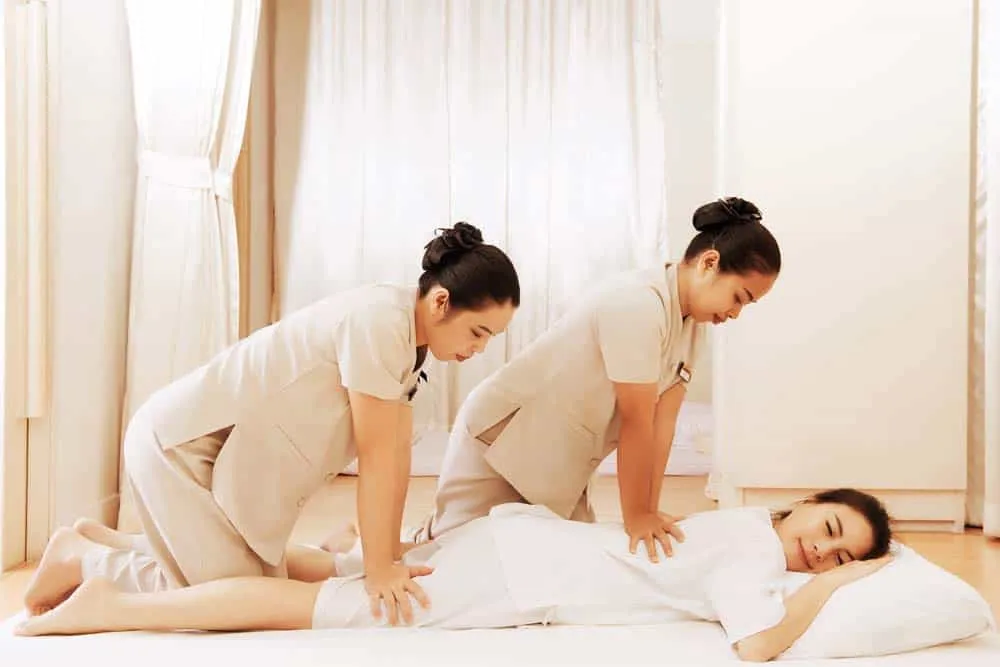
Working Process
The process of Thai massage is distinctive due to its combination of movement, pressure, and stretching. Here’s a breakdown of the typical steps involved in a Thai massage session:
1. Initial Consultation and Preparation
Before starting the massage, the practitioner will have a brief consultation with you to understand your health condition, areas of tension, flexibility level, and any specific concerns or injuries. This information helps the practitioner tailor the session to your individual needs.
The massage usually takes place in a quiet, serene environment with soft lighting and calming music. Unlike other types of massage, Thai massage does not require oils or lotions, and you remain fully clothed. It’s recommended to wear loose, comfortable clothing to allow for a full range of movement during the stretches and exercises.
2. Warm-Up and Gentle Stretching
The session typically begins with gentle stretching and warming up of the body. The practitioner may use their hands, elbows, knees, and feet to apply gentle pressure to your muscles and joints, gradually increasing the intensity to prepare your body for deeper stretches. The goal is to relax the muscles and improve circulation, making the body more receptive to the massage.
3. Application of Pressure Along Sen Lines
Thai massage is based on the concept of energy lines (Sen lines) that run throughout the body. The practitioner applies firm, rhythmic pressure along these lines using their thumbs, palms, elbows, knees, and even feet. This pressure helps stimulate energy flow, release blockages, and promote healing throughout the body. The pressure is applied slowly and deliberately to allow the muscles to relax and release tension.
4. Assisted Yoga-Like Stretching
One of the unique aspects of Thai massage is the incorporation of assisted yoga-like stretching. The practitioner gently guides you through a series of passive stretches that are designed to increase flexibility, improve range of motion, and release muscle tension. These stretches can range from gentle to more intensive, depending on your comfort level and flexibility.
- Back Stretches: These stretches focus on elongating the spine, relieving tension in the back muscles, and improving posture.
- Leg and Hip Stretches: Stretching the legs and hips helps improve flexibility, reduce stiffness, and enhance mobility in the lower body.
- Shoulder and Arm Stretches: These stretches target the upper body, releasing tension in the shoulders, arms, and neck.
- Spinal Twists: Gentle twisting movements help release tension in the spine and promote spinal flexibility.
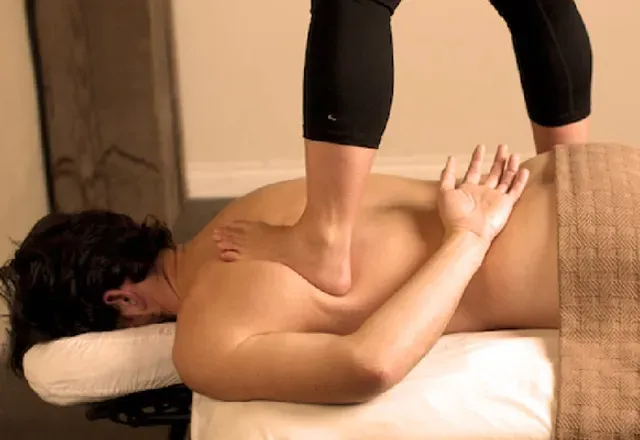
5. Rhythmic Rocking and Compression Techniques
In addition to stretching and pressure, Thai massage incorporates rhythmic rocking and compression techniques. The practitioner may gently rock your body to create a sense of relaxation and rhythm, helping to calm the nervous system and promote a deep state of relaxation. Compression techniques involve applying pressure to large muscle groups, such as the thighs or back, to release muscle tension and improve circulation.
6. Targeted Work on Specific Areas
If you have specific areas of concern, such as tight shoulders, lower back pain, or stiff hips, the practitioner will focus on these areas to provide targeted relief. This can involve deeper pressure, specialized stretches, or a combination of techniques designed to address your particular issues.
7. Cooling Down and Relaxation
The session typically concludes with gentle stretches and light pressure to help cool down the body and bring it back to a state of relaxation. This final phase helps the body integrate the benefits of the massage and encourages a sense of calm and well-being.
8. Post-Massage Care and Recommendations
After the massage, the practitioner may provide advice on aftercare, such as staying hydrated, doing gentle stretching exercises at home, and practicing mindfulness or relaxation techniques to maintain the benefits of the massage. They may also recommend follow-up sessions to address ongoing issues or enhance overall wellness.
Benefits of Thai Massage
Thai massage offers numerous benefits for both physical and mental health, making it a popular choice for those seeking a holistic approach to wellness. Some of the key benefits include:
Improves Flexibility and Range of Motion: The assisted stretching techniques in Thai massage help improve flexibility and increase the range of motion in the joints. This is particularly beneficial for athletes or individuals looking to enhance their physical performance.
Reduces Muscle Tension and Pain: The combination of deep pressure, stretching, and rhythmic movements helps release muscle tension and alleviate pain caused by muscle tightness, overuse, or injury.
Boosts Circulation and Lymphatic Flow: Thai massage stimulates blood circulation and lymphatic flow, which helps to detoxify the body, improve nutrient delivery to cells, and promote overall health and healing.
Enhances Energy Levels: By working on the body’s energy lines, Thai massage helps balance and enhance energy levels, leaving you feeling revitalized and rejuvenated.
Promotes Relaxation and Reduces Stress: The rhythmic, meditative nature of Thai massage helps calm the mind, reduce stress, and promote a deep sense of relaxation and well-being.
Improves Posture and Alignment: The stretching and alignment techniques used in Thai massage can help correct posture, improve body alignment, and reduce the strain on muscles and joints.
Strengthens the Immune System: By improving circulation, reducing stress, and promoting relaxation, Thai massage can help strengthen the immune system, making the body more resilient against illness.
Enhances Mental Clarity and Emotional Balance: The relaxing effects of Thai massage can help clear the mind, improve focus and concentration, and promote emotional balance.
Alleviates Headaches and Migraines: By releasing tension in the neck and shoulders, Thai massage can help alleviate headaches and migraines, particularly those caused by stress or muscle tension.
Conclusion
Thai massage is a unique and holistic approach to healing that combines the benefits of yoga, acupressure, and deep tissue massage. It is highly effective for relieving muscle tension, improving flexibility, reducing stress, and enhancing overall physical and mental well-being. Whether you are looking to alleviate pain, increase your range of motion, or simply relax and rejuvenate, Thai massage offers a comprehensive therapy that addresses the whole person, both body and mind.
07.Balinese Massage
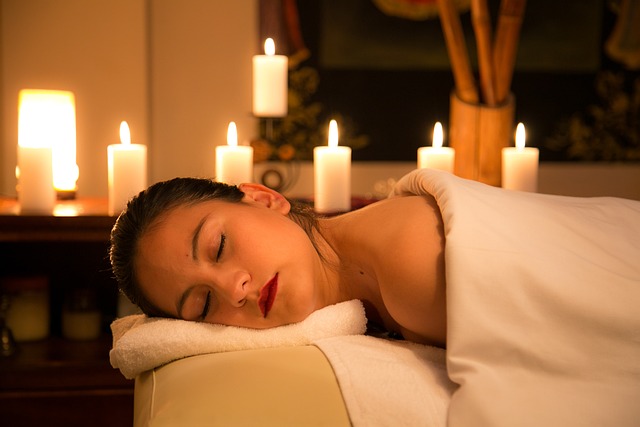
Balinese massage is a traditional massage technique originating from Bali, Indonesia, that combines a variety of massage methods to provide a holistic healing experience. This type of massage incorporates elements of traditional Indonesian massage, acupressure, reflexology, and aromatherapy. The primary goal of Balinese massage is to promote relaxation, reduce stress, and improve overall well-being by using a blend of gentle stretches, kneading, skin rolling, and deep pressure techniques. It is particularly known for its soothing and therapeutic effects, making it a popular choice for those seeking both physical relaxation and mental rejuvenation.
Balinese massage is typically performed using aromatic essential oils derived from local plants, herbs, and flowers. These oils not only provide a soothing scent that helps with relaxation but also offer various therapeutic benefits, such as moisturizing the skin and enhancing the massage’s healing properties.
Working Process of Balinese Massage
The process of Balinese massage involves several steps, each designed to enhance relaxation, relieve tension, and improve circulation throughout the body:
1. Initial Consultation and Preparation
Before the massage begins, the therapist will have a brief consultation with you to understand your specific needs, preferences, and any areas of concern. They may ask about any medical conditions, allergies, or areas of tension to tailor the massage to your needs.
The massage is usually performed in a tranquil environment, often with calming music, dim lighting, and scented candles or incense to create a relaxing atmosphere. You will be asked to lie down on a massage table, and the therapist will use towels to drape and cover your body for comfort and privacy.
2. Application of Aromatic Essential Oils
Balinese massage often begins with the application of warm aromatic essential oils to the skin. These oils are chosen based on their therapeutic properties and your preferences. The oils help nourish the skin, reduce friction during the massage, and provide a pleasant aroma that enhances relaxation.
3. Warm-Up and Gentle Stroking Techniques
The massage typically starts with gentle stroking techniques, known as effleurage, to warm up the muscles and prepare them for deeper work. These strokes are usually long and flowing, helping to promote relaxation, increase blood flow, and reduce muscle tension. This initial phase helps to calm the nervous system and set the tone for the rest of the massage.
4. Deep Tissue Massage Techniques
Once the muscles are warmed up, the therapist will begin to use deeper tissue techniques to target specific areas of tension. These techniques may include:
Kneading: The therapist uses their hands, fingers, and sometimes elbows to knead the muscles and work deeper into the tissue. This technique helps release muscle knots, improve flexibility, and relieve tension.
Skin Rolling: A technique where the therapist gently lifts and rolls the skin and underlying tissues to break up adhesions and promote relaxation. This method helps improve circulation and reduce stiffness.
Acupressure: Applying focused pressure to specific points on the body, known as acupressure points, to release tension, stimulate circulation, and promote energy flow. This technique is particularly effective for relieving muscle pain and stiffness.
Percussion: Rhythmic tapping or chopping motions with the edges of the hands or fingers to stimulate blood flow, relieve tension, and invigorate the muscles.
5. Incorporation of Reflexology
Balinese massage often incorporates elements of reflexology, particularly on the feet and hands. Reflexology is based on the principle that specific points on the feet and hands correspond to different organs and systems in the body. By applying pressure to these points, the therapist can help promote healing and balance throughout the body. This part of the massage is especially effective for improving overall relaxation and well-being.
6. Stretching and Joint Mobilization
The therapist may also incorporate gentle stretching and joint mobilization techniques to enhance flexibility, improve range of motion, and reduce muscle stiffness. These stretches are designed to complement the massage techniques and help release any remaining tension in the muscles and joints.
7. Cooling Down and Relaxation
The massage concludes with gentle strokes and light pressure to help cool down the body and promote a sense of relaxation and calm. This phase helps to integrate the benefits of the massage and allows you to fully relax before the session ends.
8. Post-Massage Care and Recommendations
After the massage, the therapist may offer some post-massage care advice, such as staying hydrated, avoiding strenuous activities, and doing gentle stretching exercises to maintain flexibility. They may also recommend follow-up sessions to continue addressing any specific concerns or to promote ongoing relaxation and wellness.
Benefits of Balinese Massage
Balinese massage offers a wide range of benefits for both physical and mental health, making it a popular choice for those seeking a comprehensive approach to relaxation and healing:
Promotes Deep Relaxation: The combination of gentle strokes, deep pressure, and aromatic essential oils helps to calm the mind, reduce stress, and promote deep relaxation.
Relieves Muscle Tension and Pain: By using a variety of massage techniques, such as kneading, acupressure, and deep tissue work, Balinese massage helps release muscle knots, reduce tension, and alleviate pain caused by muscle stiffness or injury.
Improves Circulation: The massage techniques used in Balinese massage help stimulate blood flow and improve circulation throughout the body, enhancing oxygen and nutrient delivery to the muscles and promoting overall health and healing.
Enhances Flexibility and Range of Motion: The stretching and joint mobilization techniques used in Balinese massage help improve flexibility, increase range of motion, and reduce muscle stiffness.
Boosts the Immune System: By reducing stress and improving circulation, Balinese massage can help strengthen the immune system, making the body more resilient against illnesses.
Improves Skin Health: The use of aromatic essential oils in Balinese massage helps moisturize and nourish the skin, leaving it feeling soft, smooth, and rejuvenated.
Reduces Stress and Anxiety: The relaxing environment, soothing techniques, and use of essential oils help reduce stress and anxiety, promoting a sense of calm and emotional well-being.
Promotes Better Sleep: Balinese massage can help improve sleep quality by relaxing the body and mind, making it easier to fall asleep and stay asleep.
Balances Energy and Improves Mood: The holistic approach of Balinese massage helps balance the body’s energy, improve mood, and promote overall emotional balance.
Conclusion
Balinese massage is a holistic therapy that offers a unique blend of techniques to promote relaxation, reduce stress, and improve overall well-being. By combining deep tissue massage, acupressure, reflexology, and aromatherapy, it provides a comprehensive approach to healing that benefits both the body and mind. Whether you are looking to relieve muscle tension, improve circulation, or simply relax and unwind, Balinese massage offers a soothing and therapeutic experience that can be tailored to meet your individual needs.
08.Shiatsu Massage
Shiatsu massage is a traditional Japanese form of bodywork that translates to “finger pressure.” Developed from traditional Chinese medicine (TCM) principles, Shiatsu involves applying pressure to specific points on the body, known as acupressure points, to promote the flow of energy (known as “Qi” or “Chi”) and restore balance. The technique uses fingers, thumbs, palms, elbows, and sometimes knees to apply pressure along the body’s meridians—energy pathways that are believed to correspond to different organs and systems.
Shiatsu is more than just a physical treatment; it is a holistic therapy that considers the mind and spirit, aiming to address not only physical symptoms but also emotional and mental health. Unlike Western massage techniques, which often focus on manipulating muscles and soft tissues, Shiatsu is performed on a futon or mat on the floor, and the recipient remains fully clothed in loose, comfortable attire throughout the session.
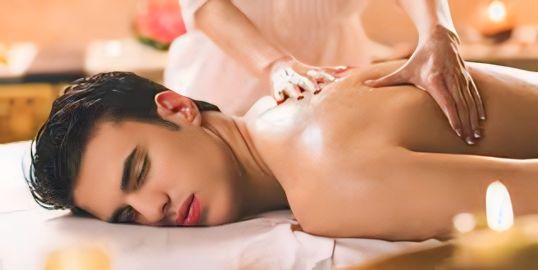
Working Process of Shiatsu Massage
The working process of Shiatsu massage involves several key steps, each designed to promote relaxation, release tension, and enhance the body’s natural healing abilities:
1. Initial Consultation and Assessment
Before starting the massage, the practitioner will conduct a brief consultation to understand your health history, specific concerns, and any areas of discomfort or tension. This helps the practitioner determine which meridians and pressure points to focus on during the session. They may ask about your lifestyle, stress levels, and any physical or emotional issues you may be experiencing.
2. Preparation and Environment
Shiatsu is usually performed in a calm, serene environment to encourage relaxation. The session takes place on a futon or mat on the floor, and you are asked to wear loose, comfortable clothing to allow for easy movement and flexibility. No oils or lotions are used in Shiatsu, as the focus is on applying pressure through clothing.
3. Application of Pressure Along Meridians
The core of Shiatsu massage involves applying firm, sustained pressure along the body’s meridians using the practitioner’s fingers, thumbs, palms, elbows, and sometimes knees. The practitioner uses their body weight to apply pressure, leaning into the points and holding the pressure for a few seconds to a minute. The pressure is generally deep and deliberate, designed to stimulate the flow of Qi and release blockages that may be causing pain or discomfort.
Thumb Pressure: The practitioner uses their thumbs to apply pressure to specific acupressure points along the meridians. This technique is particularly effective for targeting smaller areas, such as the hands, feet, and face.
Palm Pressure: Using the palms, the practitioner applies broader pressure to larger muscle groups, such as the back, shoulders, and thighs. This technique helps release tension and promote relaxation in these areas.
Elbow and Knee Pressure: For deeper, more intense pressure, the practitioner may use their elbows or knees to apply pressure to the body’s larger, thicker muscles. This technique is often used on the back, hips, and legs to release deep-seated tension.
4. Stretches and Joint Rotations
In addition to pressure techniques, Shiatsu massage incorporates gentle stretching and joint rotations to improve flexibility, increase range of motion, and reduce muscle stiffness. These movements help to relax the muscles, improve circulation, and enhance the body’s natural energy flow.
Joint Rotations: The practitioner may gently rotate and stretch the joints, such as the shoulders, hips, and wrists, to improve mobility and release tension. These movements help increase flexibility and promote relaxation.
Assisted Stretching: The practitioner may also guide you through a series of assisted stretches that target specific muscle groups and joints. These stretches help release tight muscles, improve flexibility, and enhance the overall effectiveness of the massage.
5. Focused Breathing and Relaxation Techniques
Breathing is an essential component of Shiatsu massage. The practitioner may guide you through deep, focused breathing exercises to help relax the body and mind, promote relaxation, and enhance the effects of the massage. Deep breathing helps calm the nervous system, reduce stress, and improve overall well-being.
6. Addressing Specific Areas of Concern
If you have specific areas of concern, such as tight shoulders, lower back pain, or headaches, the practitioner will focus on these areas to provide targeted relief. The practitioner will use a combination of pressure techniques, stretches, and joint rotations to release tension, improve circulation, and promote healing in these areas.
7. Cooling Down and Centering
The session typically concludes with lighter pressure techniques and gentle stretches to cool down the body and promote a sense of calm and relaxation. This phase helps integrate the benefits of the massage and encourages the body to return to a balanced, relaxed state.
8. Post-Massage Care and Recommendations
After the massage, the practitioner may provide advice on self-care techniques, such as stretching exercises, breathing exercises, and lifestyle changes, to maintain the benefits of the massage and promote overall wellness. They may also recommend follow-up sessions to continue addressing specific concerns or enhance overall health.
Benefits of Shiatsu Massage
Shiatsu massage offers numerous benefits for both physical and mental health, making it a popular choice for those seeking a holistic approach to wellness. Some of the key benefits include:
Reduces Stress and Anxiety: Shiatsu massage helps calm the nervous system, reduce stress, and promote relaxation. The deep, sustained pressure techniques help release tension, improve circulation, and promote a sense of calm and well-being.
Relieves Muscle Tension and Pain: The pressure techniques used in Shiatsu massage help release muscle tension, reduce pain, and improve flexibility. It is particularly effective for relieving tension in the neck, shoulders, back, and legs.
Improves Circulation and Lymphatic Flow: Shiatsu massage stimulates blood flow and improves circulation throughout the body, helping to deliver oxygen and nutrients to the muscles and tissues and promote overall health and healing.
Enhances Energy Levels: By working on the body’s meridians and stimulating the flow of Qi, Shiatsu massage helps balance and enhance energy levels, leaving you feeling revitalized and rejuvenated.
Boosts the Immune System: Regular Shiatsu massage can help strengthen the immune system by reducing stress, improving circulation, and promoting relaxation.
Improves Sleep Quality: Shiatsu massage helps relax the body and mind, reduce stress, and promote a sense of calm and relaxation, which can help improve sleep quality and alleviate insomnia.
Alleviates Headaches and Migraines: By releasing tension in the neck, shoulders, and head, Shiatsu massage can help alleviate headaches and migraines, particularly those caused by stress or muscle tension.
Promotes Digestive Health: Shiatsu massage can help stimulate the digestive system, improve digestion, and relieve symptoms such as bloating, constipation, and indigestion.
Improves Posture and Alignment: By releasing muscle tension and promoting relaxation, Shiatsu massage can help improve posture and alignment, reducing strain on muscles and joints.
Supports Emotional and Mental Health: Shiatsu massage promotes relaxation, reduces stress, and enhances emotional well-being, helping to support mental health and improve overall quality of life.
Conclusion
Shiatsu massage is a powerful and holistic therapy that offers a unique blend of techniques to promote relaxation, reduce stress, and improve overall well-being. By combining deep, sustained pressure with stretches, joint rotations, and breathing exercises, Shiatsu provides a comprehensive approach to healing that benefits both the body and mind. Whether you are looking to relieve muscle tension, improve circulation, or simply relax and unwind, Shiatsu massage offers a soothing and therapeutic experience that can be tailored to meet your individual needs.
.
Special Offer
15% Off for New Visitors
Maecenas exercitationem nonummy. Urna, posuere provident? Sociis voluptatibus, ridiculus maecenas minima ipsa laboris bibendum.
What Are You Waiting For...
Make An Appointment
Book your spa appointment today to experience our luxurious treatments and personalized care. Relax, rejuvenate, and unwind in our tranquil setting.
Our location
HNO : 7-1-58/CC/401 AMEERPET HYDERABAD Telangana-500018
Opening Hours
Mon-Fri: 9am-9:15pm
Sat-Sun: 9am-9:15pm
Contact
Phone: +91-9381630347,+91-8187074769 Email: nearmespaservices @gmail.com

